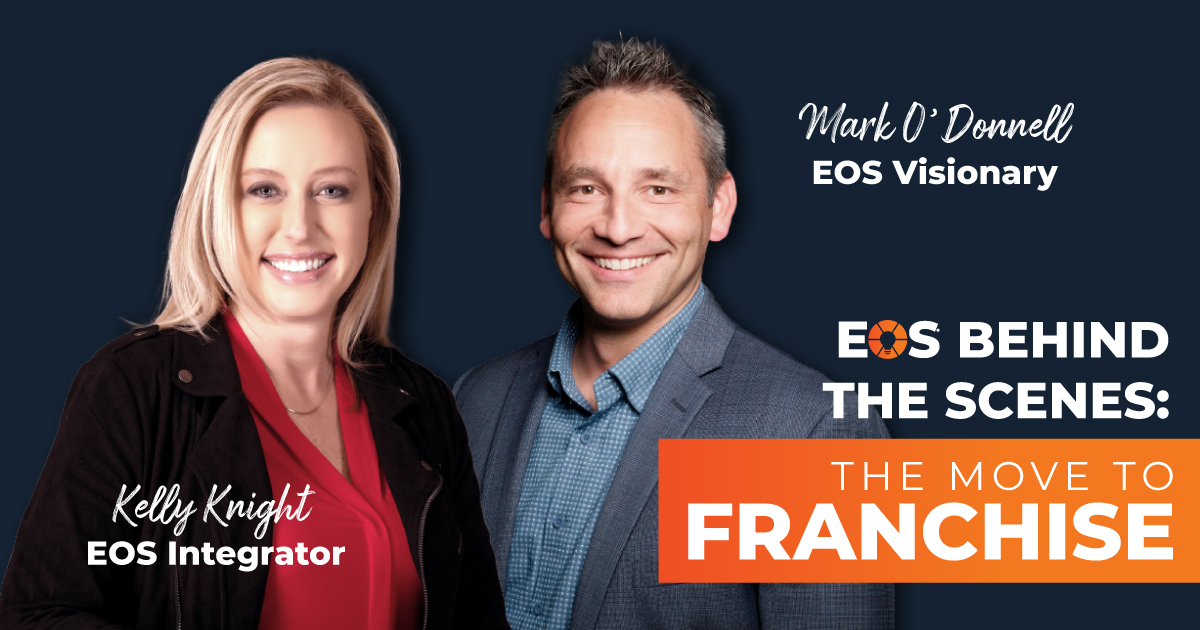
In this edition of our Behind the Scenes blog series, EOS Worldwide Integrator Kelly Knight and Visionary Mark O’Donnell talk about the factors that led EOS Worldwide to move to a franchise business model, as well as how EOS tools helped throughout the process.
Moving to a franchise model was a big decision. Did any one particular factor create the “tipping point”?
Mark: I don’t think you can reduce it to one tipping point, but the start of the pandemic was definitely the high-drama moment.
Kelly: EOS is the epitome of making lemonade out of lemons, so it was a good time to take a step back and say, if we want to continue to make an impact — if we want to stay true to our core focus of helping entrepreneurs live their ideal lives and train toward EOS mastery globally — then we have to make short- and long-term changes to the business.
Mark: We had to shift from an in-person to a virtual conference. We had to help Implementers pivot from in-person to virtual sessions without the full organizational capability to do that. And it was time to address our business model in a more aggressive way.
What role did legal considerations play in the decision?
Mark: Moving to a franchise model was 100% inevitable. Legal considerations became the catalyst for the timing, but it was already well on the way to happening because NOT being a franchise was limiting our future growth. We had to lay the groundwork for adding more value to Implementers and entrepreneurs.
Kelly: It’s important to know that there are three factors that make you a franchise. Before you trip all three of them, you need to proactively become one. You have intellectual property (IP) that you protect. You want to license that IP to a third party for a fee that they can use to make a business out of it. And you support them with sales and marketing systems that help them build and grow a business using your IP.
Every year, I would sit with our counsel, review our business model, and ask, “Do we need to make a change?” We kept hearing “no” until we started outlining all the ways we wanted to continue elevating how we help our Implementers live their EOS Life®. To provide that level of support meant moving to a franchise model.
Mark: Here are three examples: We wanted to give meaningful assistance to Implementers to help them grow their practices, eliminate confusion by consolidating the brand, and expand their revenue-earning capabilities through one-to-many workshops. With the brand, we were cannibalizing our own marketing dollars and competing against ourselves on Google AdWords, SEO, SEM, etc.
We needed to solve that to win more warm leads for Implementers. We wanted to help Implementers get their first five clients, and we couldn’t do that as a membership model. And finally, we needed to help Implementers deliver workshops outside the normal EOS Process® and gain more revenue streams. Doing any of that, we would have tripped the third point in the franchise test.
How did the two of you frame the challenge as a Visionary/Integrator team?
Kelly: I came to the realization that we had hit our own ceiling and needed to make a change, and Mark was running simulations in the lab on different scenarios and possibilities. Basically, we were looking at our goal to have 100,000 companies running on EOS, and both of us were coming back with “franchise” as the best path to get there.
Mark: The way I looked at it, we were this Wild West entrepreneurial organization based on a membership model and entrenched processes. Now we had to be either flexible or rigid, become a franchise or be okay with people taking our IP, changing it, making it too complex, or watering it down. We could either franchise now or dial back what we do to the point where it’s unrecognizable and doesn’t have the same impact.
Overall, I just couldn’t sell myself on going to a stripped-down version of EOS. It would have been a free-for-all, and no one wants their client to lack confidence in what they’re getting. We both realized that there were a lot more things to get excited about as a franchise.
Kelly: But only if we did it in a way that fit our culture and was totally in line with our core values, Core Focus™, and Core Target™.
Speaking of that, you’ve talked about EOS not being a totally traditional franchise model. Why is that important to you and the organization?
Kelly: We needed to evolve, but we also wanted to preserve what Gino created. We saw it as an opportunity to transform how people think about franchising — to see the opportunities to be entrepreneurial within a franchise model. That’s what led to decisions like not having a royalty percentage and not having territories. Every franchise I know takes a royalty. We have fixed pricing for any Implementer, regardless of their revenues, because we value them. We want to lower the barriers to entry and provide value, ROI, and freedom.
Mark: When you move to a franchise model, most of it is set in stone. That’s why the document is so big. But there are also places to offer more freedom. It’s like football: You have a strict set of guidelines for how big the field is and how to play the game, and that actually gives you MORE freedom to create your own plays, set your strategy, and compete to win.
Many of our Implementers have been in franchises, so they can see what’s so different in our setup. Our strength is that we’re a community of 700 entrepreneurial-minded people who have their own thoughts on everything we do. Our community is a blessing and we know they feel a certain stigma around the word “franchise.” We get it. Kelly and I are entrepreneurs too. We know that “franchise” doesn’t sound entrepreneurial. But we also know that it’s “confuse, you lose” on having over 700 separate brands within EOS.
Kelly: It’s also interesting that in the early days of EOS, our community was encouraged to create their own brands while Implementers actually wanted a unified, cohesive EOS — very much like a franchise model. In a way, we’ve gone full circle and are honoring that initial dynamic.
Which EOS Tools have you used in the process?
Mark: The better question is which EOS Tools haven’t we used!
Kelly: Let’s see … V/TO™, IDS™, Accountability Chart™, Level 10 Meetings™, Same Page Meetings™ … and core values are huge, especially Grow or Die and Do the Right Thing.
Mark: When I started with “100,000 companies running on EOS” and worked backwards, I kept coming back to our core values and marketing strategy inside the V/TO.
Kelly: I literally keep our V/TO on my desk daily and I look at it all the time. It’s an obsession. Whatever the issue is, you look at the V/TO and the answer comes to you. You keep going back to Core Focus and core values. We’re also addressing dozens of legacy issues called “Cleanup in Aisle 8” tasks, and we’re going to talk about those in a separate post.
So how does it feel now that the process is in motion?
Mark: Now that we’re on our way, it’s even clearer to me that it was the right decision. If we had kept things the way they were, we’d be on the wrong path and moving away from our vision instead of toward it.
Kelly: It’s a process. Of course, there will be plenty of challenges along the way, but it feels right. Between franchising and the new brand, there’s much greater clarity around our business and it’s easier to focus on what matters most: helping others, doing the right thing, breaking through ceilings, and achieving growth.





